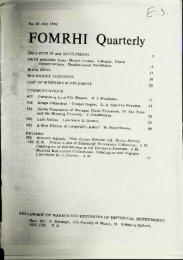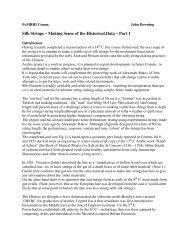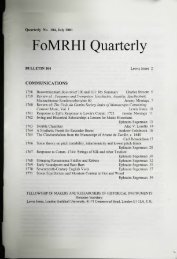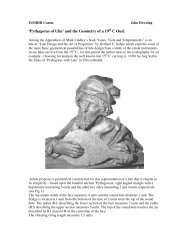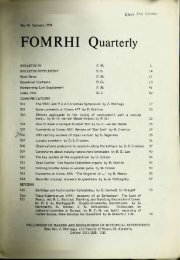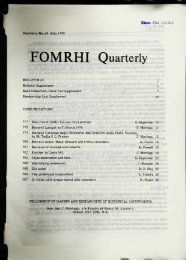• I f - FoMRHI
• I f - FoMRHI
• I f - FoMRHI
Create successful ePaper yourself
Turn your PDF publications into a flip-book with our unique Google optimized e-Paper software.
10<br />
Comm. I S 9 9<br />
About technological information in musical instruments iconography: reply to Comm.<br />
1571.<br />
A) For a long time I was involved with questions concerning the benefits of musical<br />
instrument iconographies as sources of knowledge. As others did, I also tried to<br />
"reconstruct" musical instruments shown in paintings from different ages. The aim<br />
was to experiment how e.g. flat bridges and wide tops could have been consistent<br />
with playing techniques of music kept in scores or manuscripts contemporary with<br />
the pictures. This was an extremely naive attempt to gain technological information<br />
from pictures. There was, and still is, the problem of how to solve the contrast<br />
between instrument acoustical and iconographical aspects. Obviously, my<br />
instruments were "pure imaginaries". Later I was asked to collaborate with RIDIM<br />
(University of Pavia) and I was given a large directory of names and types of<br />
instruments already identified in paintings and catalogued by "categories". It was<br />
clear that every new image discovered from iconographical sources (being examined)<br />
didn't correspond to others that had previously entered the catalogue. I was asked to<br />
study the instrument iconographical sources in Trentino (Northern Italy) and it<br />
appeared obvious that the directory should be enlarged by some dozens of types of<br />
instruments never catalogued.<br />
Then I tried to discover \i there were reasons for compiling such a list of types,<br />
because every new entry corresponded to an "unicum" and didn't pertain to a type of<br />
instrument already defined. Owing to the impossibility of explaining whether a<br />
picture can be a document of a real, already existed, type of instrument, I was to<br />
abandon the conviction that the study of instrument images should be done in order<br />
to obtain "technologically true" information. Should one accept Ch.Written II's<br />
conclusions ("Apollo, Orpheus and David" in A.M.I.S., 1,1975, p.5-55, if they were not<br />
a paradox), that some instruments were so realistically depicted, that not a few of the<br />
models can be still identified among instruments preserved in museums or private<br />
collections? It is evident to me, that the content of cognition one has to have when<br />
trying to interpret the shape and details of instruments in paintings, is so high, that<br />
the image in itself serves more to stimulate individual cognition than to be an actual<br />
means for improving the level of knoweledge.<br />
We have no serious reason for being convinced that we do concentrate on "getting the<br />
most [technological] indication of truth" out of the evidence available from the<br />
musical instrument iconography. On my opinion one has to distinguish among<br />
(1) picture and objects depicted on them - pictures are objects, as they consist of a<br />
support, materials and colours; therefore, one may study them for getting the most<br />
indication of what the picture consist of, whereas objects depicted are images,<br />
(2) the process of approaching the truth studying pictures of objects that don't exist<br />
(never can we be sure that they existed) - there is no reasons for comparing them<br />
each other, because all they are images: therefore each of them is an "unicum".<br />
It is for me unthinkable, that we can get most indication of the "truth of the evidence",<br />
ascertaing in the pictures characters that we imagine some objects should have had.





